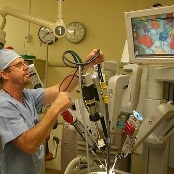The operating room of the future is already here. In the past decade, medical advancements such as robotics and noninvasive surgery have changed procedures in the OR. These technologies have not yet reached their full potential due to their novelty and cost, but you should expect to see much more of them in the next few years.
These are three of the top surgical advancements within the past decade:
Minimally Invasive/ Noninvasive Surgery
In the past, surgery was not possible without a doctor present to manually incise the patient's skin. Minimally invasive surgery, which became common in the 1980s, enabled doctors to make smaller incisions so that the patient could heal faster, but recent medical advancements are even less invasive. For example, natural orifice transluminal endoscopic surgery is a procedure where the doctor's instruments enter the body through an opening, such as the nose, instead of cutting through the skin. This means that the patient can recover even faster than with traditional minimally invasive surgery. Even more interesting is the emerging field of noninvasive surgery, where doctors operate without any instruments entering the body. In MR-guided focused ultrasound surgery, for example, a doctor uses ultrasound to destroy cancer tissue or treat other medical problems.
Robotics
If you are a prospective surgeon or surgical tech, you might work together with robots during your career. Although it's been over a decade since robots first made their appearance during surgery, they have become more common in the past ten years. A doctor typically controls the robot through a computer, moving the instruments that are in the robot's hands and seeing the entire procedure through a camera. Acting through a robot can assist doctors by giving them greater precision than their own hands offer, greater vision than their own eyes, and even an extra hand (some robots have more than two hands). Robotic surgery is typically a minimally invasive surgery — since the robot can use smaller-sized instruments than a human, the procedure results in fewer incisions.
Telesurgery
Even more fascinating than working with robots in the operating room is the ability for a doctor to perform surgery on a patient remotely. This sounds like science fiction, but several surgeons already have been able to do this during research projects. This exciting field is called telesurgery. It is a type of robot-assisted surgery wherein the surgeon is not actually physically present. In fact, he or she can be in a different country. Before this procedure becomes mainstream, however, researchers need to solve the problem with time delay due to the transmission of data between the two locations. But, why would a patient want the doctor to be located miles away during surgery? Some remote locations may not have surgeons with enough experience for a complicated procedure, and other rural areas might not have any doctors nearby. Telesurgery could also be used to perform surgery on astronauts or soldiers, or serve as training for new doctors. The possibilities are endless.
Medical science and technological innovation has been ramping up at a nearly exponential rate in recent years. With the introduction of more powerful and compact instrumentation, we expand our ability to treat people with greater efficiency and convenience. It is truly an inspiring and exciting time to be in the medical field.
Photo Source: Flickr
[cf]skyword_tracking_tag[/cf]

